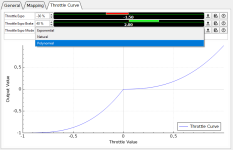Hi. I'm building a offroad utility motorbike focused on torque and control rather than speed and thrills. Since starting the project one year ago, it's been a goal for the bike to be friendly to inexperienced riders while still providing impressive hill-conquering capabilities with a heavy rider and (100+ pounds of cargo). I'm running a QS120 geared down to deliver about 300Nm of rear wheel torque on a 12" wheel.
The persistent gap in performance that I'm now confronting is delivering pleasant throttle feel on top of all that torque. I've tried controllers from ASI, Kelly, Votol, etc. and can't achieve the performance that allows the user to roll on and off the throttle with smooth transitions. As a benchmark, I own a Gogoro which is very nice in this regard and provides similar levels of torque (but also matched to much higher top speed). I've developed theories about how a throttle signal would be processed to achieve this, but I really don't want to deep dive into that world. Does anyone feel like they've solved this issue with available hardware and software?
FYI, I have not tried FarDriver or VESC controllers but don't want to try them simply as a "shot in the dark". Very much appreciate everyone's insight.
The persistent gap in performance that I'm now confronting is delivering pleasant throttle feel on top of all that torque. I've tried controllers from ASI, Kelly, Votol, etc. and can't achieve the performance that allows the user to roll on and off the throttle with smooth transitions. As a benchmark, I own a Gogoro which is very nice in this regard and provides similar levels of torque (but also matched to much higher top speed). I've developed theories about how a throttle signal would be processed to achieve this, but I really don't want to deep dive into that world. Does anyone feel like they've solved this issue with available hardware and software?
FYI, I have not tried FarDriver or VESC controllers but don't want to try them simply as a "shot in the dark". Very much appreciate everyone's insight.




